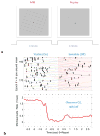Motion-induced blindness and microsaccades: cause and effect
- PMID: 21172899
- PMCID: PMC3075454
- DOI: 10.1167/10.14.22
Motion-induced blindness and microsaccades: cause and effect
Abstract
It has been suggested that subjective disappearance of visual stimuli results from a spontaneous reduction of microsaccade rate causing image stabilization, enhanced adaptation, and a consequent fading. In motion-induced blindness (MIB), salient visual targets disappear intermittently when surrounded by a moving pattern. We investigated whether changes in microsaccade rate can account for MIB. We first determined that the moving mask does not affect microsaccade metrics (rate, magnitude, and temporal distribution). We then compared the dynamics of microsaccades during reported illusory disappearance (MIB) and physical disappearance (Replay) of a salient peripheral target. We found large modulations of microsaccade rate following perceptual transitions, whether illusory (MIB) or real (Replay). For MIB, the rate also decreased prior to disappearance and increased prior to reappearance. Importantly, MIB persisted in the presence of microsaccades although sustained microsaccade rate was lower during invisible than visible periods. These results suggest that the microsaccade system reacts to changes in visibility, but microsaccades also modulate MIB. The latter modulation is well described by a Poisson model of the perceptual transitions assuming that the probability for reappearance and disappearance is modulated following a microsaccade. Our results show that microsaccades counteract disappearance but are neither necessary nor sufficient to account for MIB.
Figures







References
-
- Benjamini Y, Yekutieli D. The control of the false discovery rate in multiple testing under dependency. Annals of Statistics. 2001;29(4):1165–1188.
-
- Blake R, Logothetis NK. Visual competition. Nat Rev Neurosci. 2002;3(1):13–21. - PubMed
-
- Bonneh YS, Cooperman A, Sagi D. Motion-induced blindness in normal observers. Nature. 2001;411(6839):798–801. - PubMed
-
- Cornsweet TN. Determination of the stimuli for involuntary drifts and saccadic eye movements. J Opt Soc Am. 1956;46(11):987–993. - PubMed
Publication types
MeSH terms
Grants and funding
LinkOut - more resources
Full Text Sources

